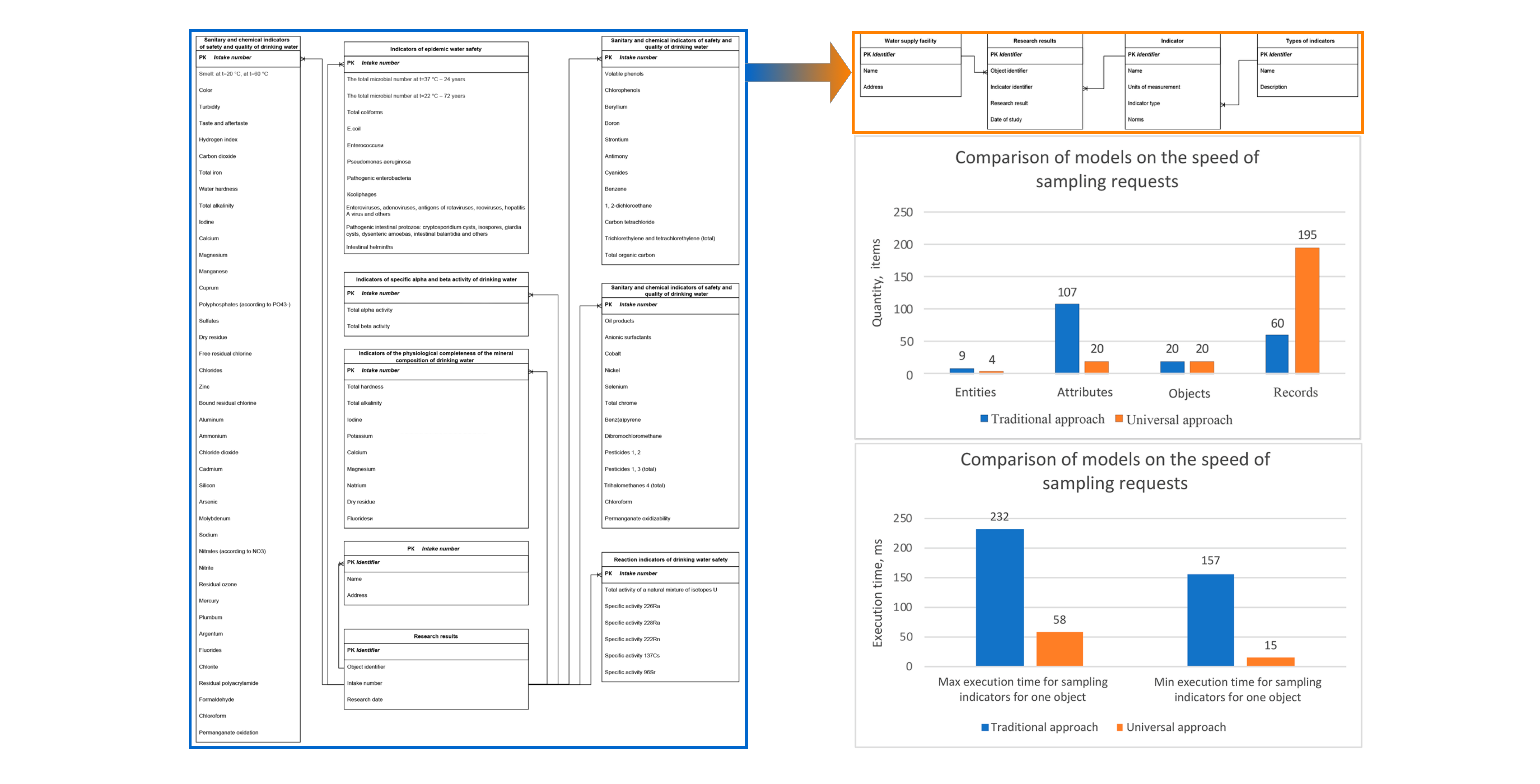Investigation of approaches to designing complex database structures in systems of integrated monitoring of environmental, economic, energy and social parameters of the territory
DOI:
https://doi.org/10.15587/2706-5448.2024.302396Keywords:
database design, database structure, complex monitoring, environment, public healthAbstract
The object of research is the traditional and universal approach of designing the database structure in systems of integrated monitoring of ecological, economic, energy and social parameters of the territory, which include diverse data from various subject areas. In the course of the study, an analysis was performed based on a set of criteria such as scalability, ease of updating data, absence of empty fields, volume of the database, number of tables and fields, ease and speed of execution of requests for a sample set of indicators of the research object. The comparison of these approaches took place on the example of water resources monitoring, since it has several subsystems and a large number of indicators that are used for assessment. It is established that the proposed universal approach to designing complex database structures made it possible to reduce the volume of the database by 2.25 times due to the absence of empty fields. In particular, in the considered example, the filling factor of the database with the traditional approach is 1.75 times less than with the proposed universal approach. It should be noted that the rate of table filling for the traditional design approach can vary depending on the number of indicator values, while the table filling rate for the universal approach is always close to 100 %. Also, the proposed database design approach makes it possible to speed up data loading and processing. For example, with the same volume of significant information, the minimum speed of sampling the characteristics of one research object is 3.87 times greater in a database developed according to the principles of the universal approach than according to the rules of the traditional approach. The proposed structure of the database is successfully used in the system of complex eco-energy-economic monitoring. The developed structure of the database can serve as an effective basis for the formation of an electronic data bank at the level of the enterprise, region and country.
References
- Slipchenko, V. H., Poliahushko, L. H., Krush, O. Ye. (2021). The system of complex eco-energy-economic monitoring to optimize management decisions (region, district and city). Visnik of the Volodymyr Dahl East Ukrainian National University, 4 (268), 13–20. doi: https://doi.org/10.33216/1998-7927-2021-268-4-13-20
- Slipchenko, V., Poliahushko, L., Krush, O. (2022). Developing an automated system for collecting various information in the system of complex eco-energy-economic monitoring. Technology Audit and Production Reserves, 3 (2 (65)), 11–18. doi: https://doi.org/10.15587/2706-5448.2022.259069
- Xia, J., Lin, L., Lin, J., Nehal, L. (2014). Development of a GIS-Based Decision Support System for Diagnosis of River System Health and Restoration. Water, 6 (10), 3136–3151. doi: https://doi.org/10.3390/w6103136
- Kuznichenko, S. D., Buchynska, I. V. (2021). Modeli, metody ta instrumentalni zasoby bahatokryterialnoho analizu rishen v heoinformatsiinykh systemakh. Zhytomyr: TOV «505», 202.
- Halchenko, N. P., Kozar, V. I. (2019).The structure of the data bases for the provision of geoinformation monitoring of the nature reserve fund lands. Ekolohichna bezpeka, 1 (27), 32–37.
- Saranenko, I. I. (2018). Stvorennia bazy danykh ekolohichnoho stanu hruntiv u MICROSOFT ACCESS. Ekolohichni nauky, 2 (21), 74–80.
- Sanhinova, O. V., Kraieva, K. O., Andriiuk, V. K., Arkhipova, A. O. (2018). Database of water bodies and services of the water quality monitoring system. Computer modeling for chemistry, technologies and sustainable development systems. Kyiv: KPI im. Ihoria Sikorskoho, 214–216.
- Ekolohichnyi monitorynh dovkillia. Ministerstvo zakhystu dovkillia ta pryrodnykh resursiv Ukrainy. Available at: https://mepr.gov.ua/diyalnist/napryamky/ekologichnyj-monitoryng/ekologichnyj-monitoryng-dovkillya/ Last accessed: 15.03.2023
- Vangu, G. M., Croitoru, A., Mitrache, M., Dima, N. (2023). Design of a GIS Database for Surface Mining. Journal of Applied Engineering Sciences, 13 (2), 289–296. doi: https://doi.org/10.2478/jaes-2023-0037
- «Vidkryte dovkillia». Ofitsiinyi portal ministerstva zakhystu dovkillia ta pryrodnykh resursiv. Available at: http://openenvironment.org.ua/index.htm?sl=UA Last accessed: 15.03.2023
- What is Risk Based Corrective Action (RBCA)? Atlantic RBCA. Available at: https://atlanticrbca.com/faq/what-is-risk-based-corrective-action-rbca/ Last accessed: 14.09.2021
- Pro zatverdzhennia Derzhavnykh sanitarnykh norm ta pravyl «Hihiienichni vymohy do vody pytnoi, pryznachenoi dlia spozhyvannia liudynoiu» (DSanPiN 2.2.4-171-10) (2010). Nakaz MOZ Ukrainy No. 400. 12.05.2010. Available at: https://zakon.rada.gov.ua/laws/show/z0452-10#Text Last accessed: 15.03.2023
- Osnovy rozrobky baz danykh. Microsoft. Available at: https://support.microsoft.com/uk-ua/topic/%D0%BE%D1%81%D0%BD%D0%BE%D0%B2%D0%B8-%D1%80%D0%BE%D0%B7%D1%80%D0%BE%D0%B1%D0%BA%D0%B8-%D0%B1%D0%B0%D0%B7-%D0%B4%D0%B0%D0%BD%D0%B8%D1%85-eb2159cf-1e30-401a-8084-bd4f9c9ca1f5#bmterms Last accessed: 15.03.2023
- Shchodo yakosti pytnoi vody. Sait Kyivvodokanal. Available at: https://www.vodokanal.kiev.ua/shhodo-yakosti-pytnoi-vody Last accessed: 16.04.2024

Downloads
Published
How to Cite
Issue
Section
License
Copyright (c) 2024 Volodymyr Slipchenko, Liubov Poliahushko, Olha Krush, Volodymyr Rudyk

This work is licensed under a Creative Commons Attribution 4.0 International License.
The consolidation and conditions for the transfer of copyright (identification of authorship) is carried out in the License Agreement. In particular, the authors reserve the right to the authorship of their manuscript and transfer the first publication of this work to the journal under the terms of the Creative Commons CC BY license. At the same time, they have the right to conclude on their own additional agreements concerning the non-exclusive distribution of the work in the form in which it was published by this journal, but provided that the link to the first publication of the article in this journal is preserved.







